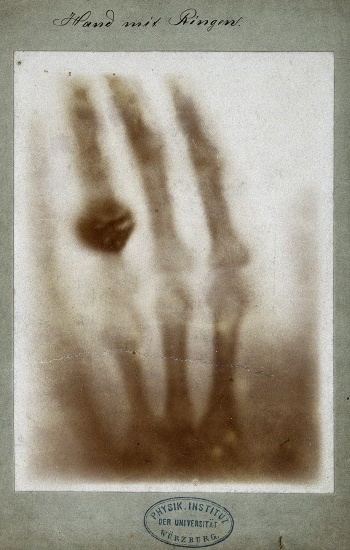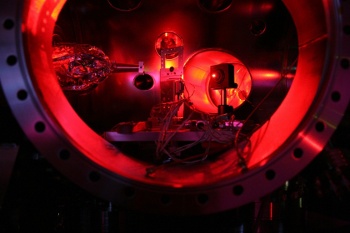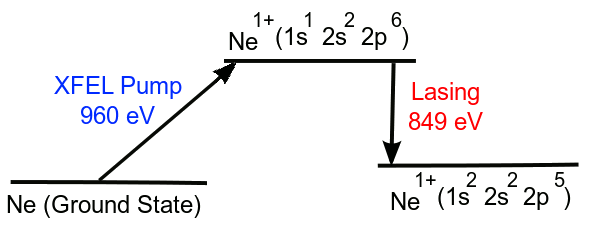An X-ray Laser
January 30, 2012
Many years ago, I collaborated with
scientists of the
Stanford Linear Accelerator Center, now known as the
SLAC National Accelerator Laboratory, on an interesting project. The SLAC experiment was on
resonant nuclear diffraction, and my task was the preparation of
epitaxial layers of
yttrium iron garnet with
isotopically-enriched iron (
57Fe).
The isotopically-enriched
iron oxide I was given had a high monetary value, and it was loaned to SLAC from another source. I needed to keep the small bottle of iron oxide in my
safe along with the
platinum ware. After my
crystal growth, the iron was reclaimed
chemically from the residue in my
crucible.
Both the SLAC team and I used
X-rays to characterize the crystalline quality of this material. In a special
X-ray diffraction apparatus called a
double crystal diffractometer it's possible to measure the width of the X-ray diffraction lines, and this is indicative of the quality of the crystal.
X-rays are an extremely useful portion of the
electromagnetic spectrum. X-rays have been the motivation for quite a few
Nobel Physics Prizes. There is, of course,
Wilhelm Röntgen, who won the first Nobel Physics Prize in 1901 for his discovery of X-rays, and also the following:
• Max von Laue, who won the 1914 Prize for his discovery of the diffraction of X-rays by crystals.
The father and son team of William Henry Bragg and William Lawrence Bragg, who won the 1915 Prize for X-ray crystallography.
• Charles Glover Barkla, who won the 1917 Prize for X-ray spectroscopy.
• Manne Siegbahn, who won the 1924 Prize for X-ray spectroscopy.
• Riccardo Giacconi, who won the 2002 Prize for the discovery of cosmic X-ray sources.

The first medical X-ray.
This is a print of one of Röntgen's first X-rays, that of his wife's hand. This X-ray, dated December 22, 1895, is entitled Hand mit Ringen (Hand with Ring).
(Via Wikimedia Commons))
The development of technical light sources allowed the development of the science of
optics, but it was only after the invention of the
laser that the field of optics really took off. An X-ray laser would, likewise, be a useful element in the
physics toolbag for things such as precision
spectroscopy and
nonlinear X-ray studies.[3-4]
Unfortunately, making an X-ray laser is much more difficult than making an optical laser. First, you need to pump the laser at a higher energy than the X-ray you're trying to produce; and, second, you need a material with the right
atomic energy levels and
excited state lifetimes to permit lasing.
A team from
Lawrence Livermore National Laboratory,
Colorado State University and the
NSF Engineering Research Center for Extreme Ultraviolet Science and Technology, and the SLAC National Accelerator Laboratory has just published a report on an X-ray laser emitting a 1.46
nanometer femtosecond high-intensity X-ray pulse from a
neon gas medium. This wasn't the first reported atomic X-ray laser, but it was the most intense.[3-6]
The
pump source was an
X-ray free-electron laser, SLAC's
Linac Coherent Light Source (LCLS). This $410 million X-ray laser produces X-ray pulses ten billion times brighter than any previous X-ray source.[3] The X-ray intensity, 200
terawatts, is so great, that when it irradiated a foil of
aluminum, it created a
plasma of "hot-dense matter" with a
temperature of two million degrees
Celsius (see photograph).[3, 7-9] Hot-dense matter is contained in
stellar interiors and at the centers of
gas giant planets, such as
Jupiter.[7]

The interior of an LCLS experimental chamber at SLAC. This chamber contained the aluminum foil specimen that was transformed into two million degree hot dense matter.
(Photo by Sam Vinko/University of Oxford, via SLAC Web Site.)
Used with permission)
The LCLS had sufficient energy to
ionize and excite neutral neon atoms to their (1s
12s
22p
6) state, where they lased to (1s
22s
22p
5) and emitted 1.46 nm (849
eV) X-ray
photons (see figure). This is the so-called
Kα transition.

X-ray lasing in neon. The X-ray free electron laser (XFEL) pumps the gas at 960 eV, and the lasing transition emits X-rays at 849 eV (1.46 nm). (Illustration by author, rendered by Inkscape).
Since the SLAC Linac Coherent Light Source is already an X-ray laser, why would you want to use it to generate X-rays in neon? The neon X-rays are more monochromatic, having about 12% the linewidth of the LCLS.[8]
One interesting conjecture about X-ray lasers was recited by
Adrian Cho in his review of SLAC neon X-ray laser in
Science. Cho says that development of an X-ray laser may have been part of the
US Strategic Defense Initiative in the 1980s. In that case, the pump source would have been an
underground nuclear explosion![3]
References:
- D.M. Gualtieri, W. Lavender and S. Ruby, "57Fe-YIG: Narrow Xray Linewidth Epitaxial Layers on Gd3Ga5O12," Journal of Applied Physics, vol. 63, no. 8 (April 15, 1988), pp. 3795-3797.
- J. Arthur, D. E. Brown, S. L. Ruby, G. S. Brown and G. K. Shenoy, "Studying hyperfine fields with resonant nuclear diffraction of x rays,", vol. 67, no. 9 (May 1, 1990), pp. 5705-5709.
- Adrian Cho, "Physicists Squeeze X-Ray Laser Light Out of Atoms," Science Now,January 25, 2012.
- Nina Rohringer, Duncan Ryan, Richard A. London, Michael Purvis, Felicie Albert, James Dunn, John D. Bozek, Christoph Bostedt, Alexander Graf, Randal Hill, Stefan P. Hau-Riege and Jorge J. Rocca, "Atomic inner-shell X-ray laser at 1.46 nanometres pumped by an X-ray free-electron laser," Nature, vol. 481, no. 7382 (January 26, 2012), pp. 488-491.
- Jon Marangos, "Laser science: Even harder X-rays," Nature, vol. 481, no. 7382 (January 26, 2012), pp. 452-453.
- Supplementary information for Ref. 5.
- Andy Freeberg, "World's Most Powerful X-ray Laser Creates 2-Million-Degree Matter," SLAC National Accelerator Laboratory Press Release, January 25, 2012.
- Richard Chirgwin, "Two million-degree matter from SLAC laser," The Register (UK), January 25, 2012.
- Adam Mann, "X-Ray Laser Turns Up the Heat to 3.6 Million Degrees," Wired, January 25, 2012.
Permanent Link to this article
Linked Keywords: Scientist; Stanford Linear Accelerator Center; SLAC; SLAC National Accelerator Laboratory; resonance; nuclear; diffraction; epitaxy; yttrium iron garnet; isotope separation; isotopically-enriched; iron; 57Fe; iron oxide; safe; platinum; crystal growth; chemical reaction; crucible; X-ray; diffractometer; X-ray diffraction apparatus; double crystal diffractometer; electromagnetic spectrum; Nobel Physics Prize; Wilhelm Röntgen; Max von Laue; William Henry Bragg; William Lawrence Bragg; Charles Glover Barkla; X-ray spectroscopy; Manne Siegbahn; Riccardo Giacconi; Wikimedia Commons; optics; laser; physics; spectroscopy; nonlinear optics; atomic; energy level; excited state; lifetime; Lawrence Livermore National Laboratory; >Colorado State Universit; NSF Engineering Research Center for Extreme Ultraviolet Science and Technology; nanometer; femtosecond; neon gas; pump source; X-ray free-electron laser; Linac Coherent Light Source; terawatt; aluminum; plasma; temperature; Celsius; stellar; gas giant planet; Jupiter; Sam Vinko; University of Oxford; ionization; electronvolt; eV; photon; K-edge; Kα transition; Inkscape; Adrian Cho; Science; US Strategic Defense Initiative; underground nuclear explosion.